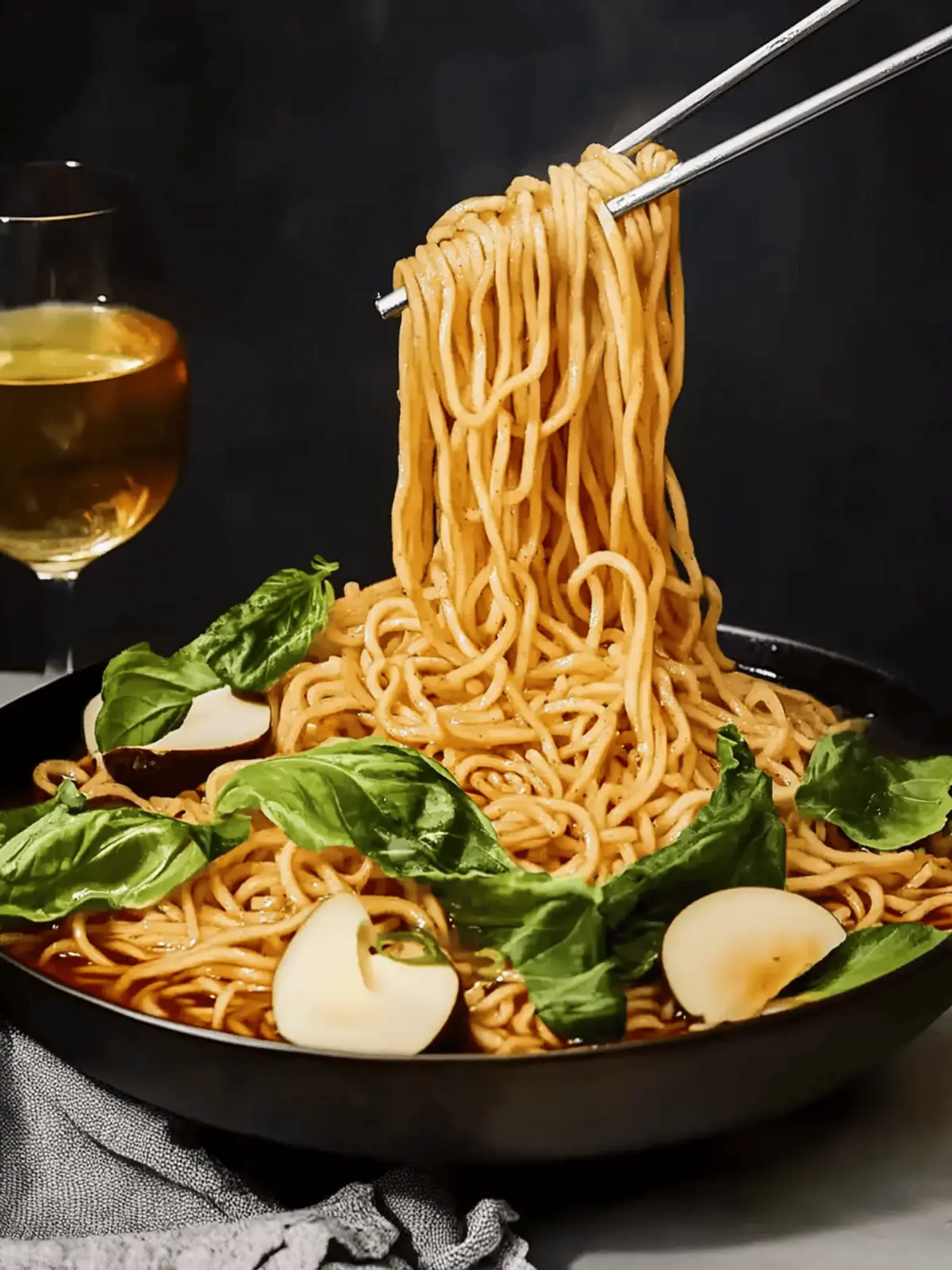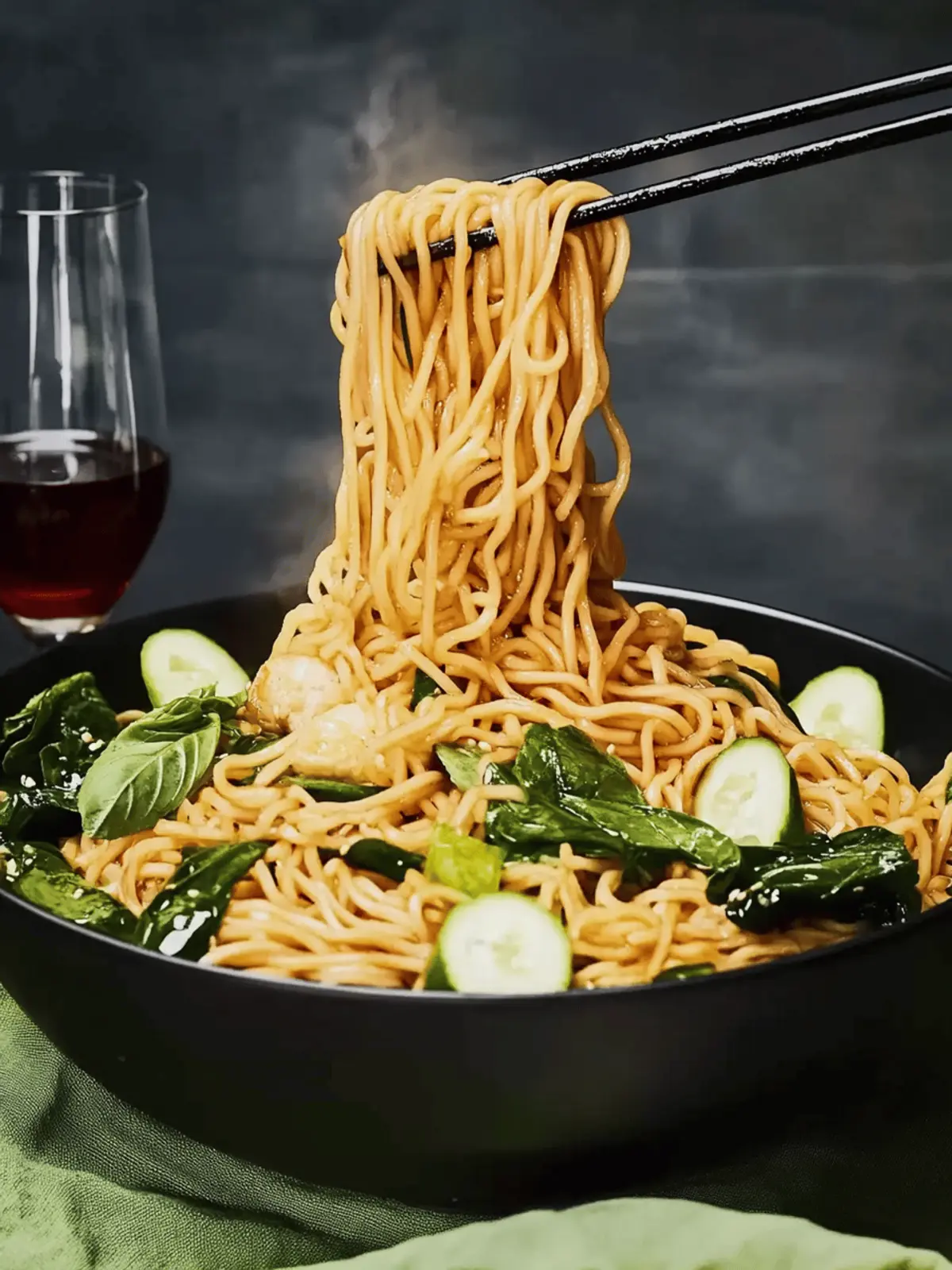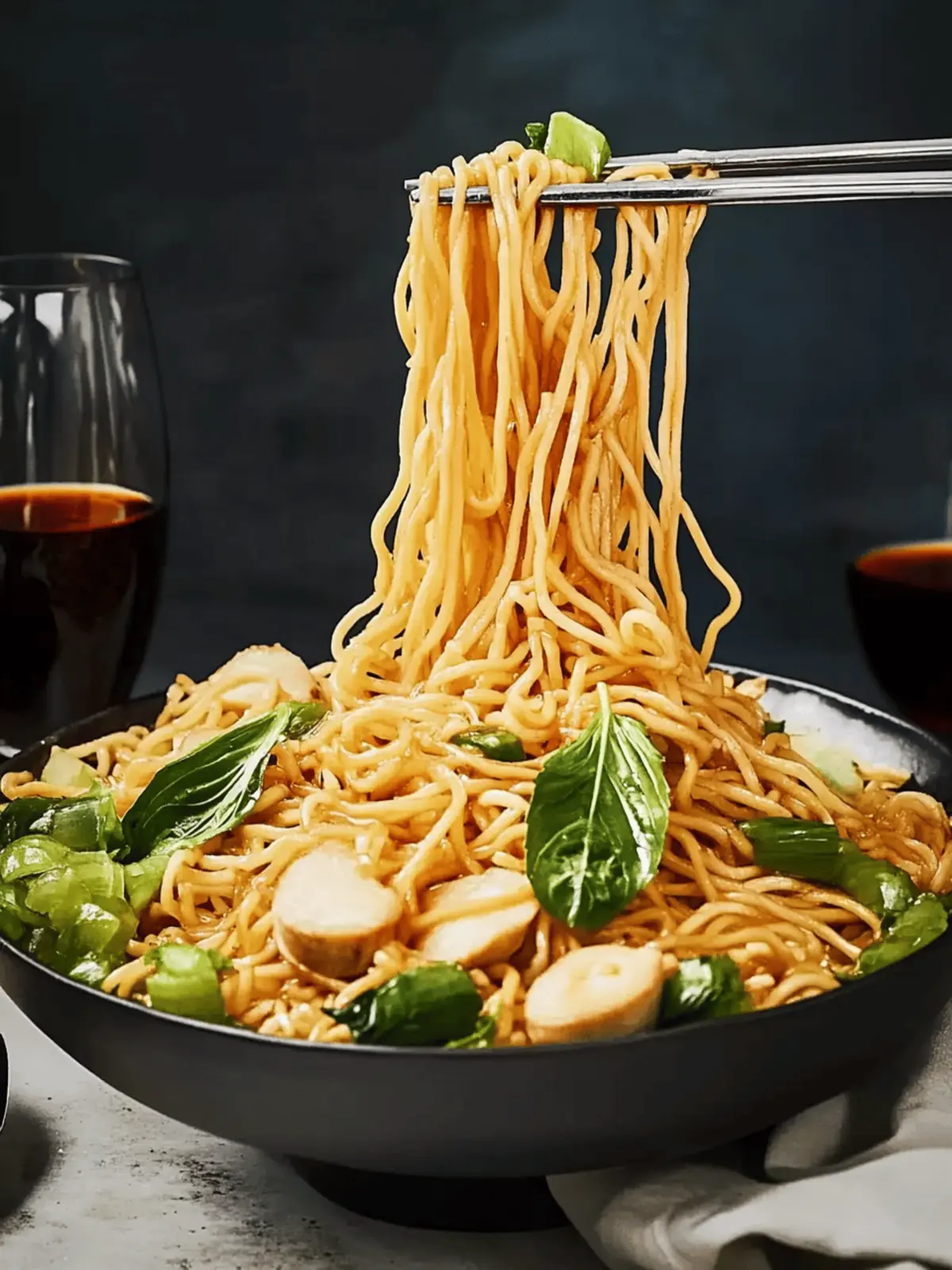As the sun begins to set, casting a warm glow over my kitchen, I find myself driven by a craving for something comforting yet vibrant. That’s when I reach for some bright, fresh vegetables and a packet of longevity noodles, my secret weapon against the monotony of takeout. The satisfying stretch of those silky noodles pairs perfectly with the crisp snap of snow peas and the delightful crunch of water chestnuts.
This dish not only comes together in a flash, but each bite bursts with flavor thanks to the umami-infused sauce that ties it all together. Whether it’s a cozy weeknight dinner or a quick dish to impress friends at a gathering, these longevity noodles deliver on every front. Plus, they’re a fantastic way to celebrate fresh ingredients and elevate your culinary repertoire. Join me in whipping up this delightful Lo Mein, and let yourself be swept away by the comforting embrace of homemade noodles!
Why Longevity Noodles Will Delight You
Quick and Easy: Whip up this dish in no time, making it perfect for busy evenings or spontaneous guests.
Flavor Explosion: The combination of vibrant vegetables and the umami-rich sauce creates a mouthwatering experience you won’t forget.
Crunchy Texture: Enjoy the delightful contrast between silky noodles and crisp snow peas and water chestnuts.
Customizable: Feel free to add your favorite proteins or veggies for a personal touch.
Health-Conscious Choice: Packed with fresh ingredients, this dish is a wholesome alternative to takeout.
Dive into this scrumptious recipe, and discover a new family favorite!
Longevity Noodles Ingredients
• Discover the essential components for creating delightful Longevity Noodles!
For the Noodles
- Chinese egg noodles – These silky noodles are the star; feel free to substitute with udon for a different texture.
- Salt – Enhances flavor; just the right amount is key for a deliciously seasoned dish.
- Water – Ensures a perfect boil for cooking the noodles to al dente bliss.
For the Vegetables
- Fresh mung bean sprouts – These add a delightful crunch; soybean sprouts also work beautifully if preferred.
- Snow peas – Their bright green color and sweet flavor elevate any dish.
- Water chestnuts – Sliced thin, they introduce a satisfying crunch that pairs wonderfully with the noodles.
For the Sauce
- Chicken stock or vegetable stock – Use low-sodium options for a healthier choice while enhancing the dish’s overall flavor.
- Light soy sauce – This provides that savory umami taste; you can adjust according to your salt preference.
- Asian sesame oil – Just a hint adds an aromatic depth that’s simply unforgettable.
For Cooking
- Peanut oil – Known for its high smoke point, this oil brings flavor and helps achieve perfect wok cooking.
- Fresh ginger – Lightly smashed, it infuses the dish with warm, spicy notes throughout the cooking process.
With these essential ingredients, you’re on your way to cooking up a delightful bowl of Longevity Noodles that your family and friends will rave about!
How to Make Longevity Noodles
-
Boil Water: Fill a large saucepan with 2 quarts of water and bring it to a robust boil over high heat.
-
Blanch Bean Sprouts: Place the bean sprouts in a metal strainer and dip them into the boiling water for about 10 seconds. They should become crisp-tender. Rinse under cold water for 30 seconds to stop the cooking. Drain well and set aside.
-
Cook Noodles: Make sure to add the salt to the boiling water, then return it to a boil. Add the noodles, stirring often, and cook until just under al dente, roughly 1 minute. Drain and rinse under cold water for 1 minute, then set aside.
-
Mix Sauce: In a small bowl, combine chicken stock, light soy sauce, and sesame oil. This is your flavorful sauce; set it aside for later!
-
Heat Oil: In a wok, heat the peanut oil over high heat until it shimmers. Swirl the oil to ensure it coats the wok beautifully.
-
Infuse Flavor: Add the smashed ginger and stir constantly for about 10 seconds, allowing it to sizzle and turn golden at the edges.
-
Cook Vegetables: Toss in the snow peas and stir for about 1 minute until they’re bright green. Then, quickly add the water chestnuts and stir for an additional 30 seconds. Finally, incorporate the blanched bean sprouts, stirring until they wilted, around 1 minute.
-
Combine: Pour the sauce into the wok and bring to a boil over high heat. Add the cooked noodles, stirring continuously for around 2 minutes until they absorb the sauce and become richly flavored. Discard the ginger slice before serving.
-
Serve: Transfer the beautifully mixed noodles to a platter and serve hot for an invigorating meal!
Optional: Garnish with chopped green onions for an extra pop of color and flavor.
Exact quantities are listed in the recipe card below.

What to Serve with Longevity Noodles?
Cozy up your dining experience with delightful pairings that elevate the flavor and charm of your homemade noodles.
- Light Spring Rolls: These are a perfect starter; the crisp vegetable fillings contrast beautifully with the texture of the noodles.
- Sesame Stir-Fried Broccoli: This dish’s crunchy broccoli adds both flavor and nutrients, creating a balanced meal for the family.
- Soy Sauce Glazed Tofu: Its rich flavor complements the umami notes of the Longevity Noodles, making it a satisfying protein addition.
- Chili Garlic Edamame: The spicy kick enhances the noodle dish, inviting everyone to savor the delicious mingling of flavors.
- Crispy Peking Duck: Offering a touch of luxury, the tender duck pairs exceptionally well and adds a delightful punch of richness.
- Coconut Milk Rice Pudding: For a sweet finish, this creamy dessert provides a perfect ending with its hint of tropical flavor, balancing the savory main course.
Each pairing brings an exciting dimension, ensuring your meal is a delightful adventure!
Make Ahead Options
These Longevity Noodles are perfect for meal prep enthusiasts looking to save time during busy weeknights! You can blanch the bean sprouts and snow peas up to 24 hours in advance, just make sure to refrigerate them in an airtight container to maintain their crispness. The noodles can also be cooked and stored in the fridge if you toss them with a little peanut oil to prevent sticking. When you’re ready to enjoy your Longevity Noodles, simply reheat the noodles in a wok, add the prepped vegetables, stir in your sauce, and cook until everything is heated through. You’ll effortlessly serve up a delicious homemade meal with minimal effort!
Longevity Noodles Variations
Feel free to explore new flavors and textures to make this dish uniquely yours!
- Vegetarian: Replace chicken stock with vegetable stock for a meat-free option that’s equally satisfying.
- Noodle Alternative: Swap out Chinese egg noodles for rice noodles or whole wheat spaghetti for a different texture.
- Protein-Packed: Add shrimp, chicken, or tofu for a protein boost that will make this dish even more hearty. These ingredients will absorb the rich flavors beautifully, making each bite delightful!
- Extra Crunch: Toss in chopped nuts like cashews or peanuts to enhance crunch and add a nutty flavor that complements the dish perfectly.
- Spicy Kick: Sprinkle in red pepper flakes or Sriracha to give your noodles a lovely heat that will awaken your taste buds.
- Seasonal Veggies: Experiment with seasonal vegetables such as bell peppers, carrots, or bok choy for a fresh twist that keeps your meals exciting. Each additional vegetable can add its own unique flavor profile!
- Herb Infusion: Incorporate fresh herbs like cilantro or basil at the end for a bright and aromatic finish that elevates the dish’s flavor.
- Citrus Zing: A squeeze of lime or lemon juice just before serving can brighten the flavors and add a refreshing contrast that makes the dish sing!
With so many possibilities, your Longevity Noodles will never feel boring!
How to Store and Freeze Longevity Noodles
Fridge: Store leftover longevity noodles in an airtight container for up to 3 days. If possible, separate the noodles and vegetables to maintain texture.
Freezer: If you plan ahead, freeze the noodles without the sauce for up to 2 months. Use freezer-safe containers, and be sure to label them.
Reheating: Thaw in the fridge overnight before reheating on the stove or in the microwave. Add a splash of broth or water to restore moisture and bring back the dish’s original flavor.
Airtight Containers: For best results, always store your noodles and any leftovers tightly wrapped to prevent freezer burn or drying out.
Expert Tips for Longevity Noodles
-
Perfect Blanching: Ensure bean sprouts are blanched quickly—only 10 seconds. Overcooking will cause them to lose their crunch.
-
Sauce Balance: Taste the sauce before adding it to the noodles. It’s easier to adjust the light soy sauce to your liking before mixing.
-
Noodle Timing: Cook your longevity noodles until just under al dente for the perfect chewy texture. Drain properly to avoid mushiness.
-
Vegetable Freshness: Use fresh snow peas and crisp water chestnuts for the best texture and flavor contrast. Don’t substitute with canned veggies!
-
Wok Heat: Make sure your peanut oil is hot enough before adding ginger and vegetables. A well-heated wok gives the dish a vibrant, authentic stir-fried taste.

Longevity Noodles with Snow Peas and Water Chestnuts Recipe FAQs
What type of noodles should I use for longevity noodles?
Absolutely! Traditional Chinese egg noodles are ideal for this dish, providing that perfect chewy texture. If you can’t find them, udon noodles are a great alternative and can hold up beautifully in this recipe.
How should I store leftovers?
I recommend keeping leftover longevity noodles in an airtight container in the fridge for up to 3 days. For optimal freshness, try to separate the noodles from the vegetables before storing to help maintain their texture.
Can I freeze longevity noodles?
Yes, you can! To freeze, place the noodles (without sauce) in freezer-safe containers. They can last for up to 2 months. Just remember to label them with the date for easy tracking. When you’re ready to enjoy, thaw them in the fridge overnight, then reheat in a pan with a splash of chicken broth or water to rejuvenate the flavors.
What if my noodles become mushy during cooking?
Very! The key is to cook your longevity noodles just under al dente—about 1 minute in boiling water should do it. If they start to become mushy, drain them immediately and rinse under cold water. This stops the cooking process and helps maintain that lovely chewy bite.
Are longevity noodles suitable for people with allergies?
Yes, but be cautious! Traditional recipes include soy sauce and peanut oil, both of which can trigger allergies in some individuals. If you or your guests have specific dietary restrictions, consider using gluten-free soy sauce and oils that align with your dietary preferences. Always double-check ingredient labels for potential allergens.

Delicious Longevity Noodles with Snow Peas and Crunchy Chestnuts
Ingredients
Equipment
Method
- Fill a large saucepan with 2 quarts of water and bring it to a robust boil over high heat.
- Place the bean sprouts in a metal strainer and dip them into the boiling water for about 10 seconds. Rinse under cold water for 30 seconds, then drain and set aside.
- Add salt to the boiling water, then add the noodles, stirring often. Cook until just under al dente, roughly 1 minute. Drain and rinse under cold water for 1 minute, then set aside.
- In a small bowl, combine chicken stock, light soy sauce, and sesame oil. Set aside.
- In a wok, heat peanut oil over high heat until it shimmers. Swirl the oil to coat the wok.
- Add smashed ginger and stir constantly for about 10 seconds until golden.
- Toss in the snow peas and stir for about 1 minute until bright green. Add water chestnuts and stir for an additional 30 seconds, then add blanched bean sprouts until wilted, around 1 minute.
- Pour the sauce into the wok and bring to a boil. Add the cooked noodles, stirring continuously for around 2 minutes until they absorb the sauce. Discard the ginger slice before serving.
- Transfer the noodles to a platter and serve hot. Optional: Garnish with chopped green onions.






